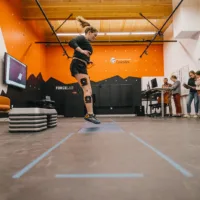
An abrupt switch to minimal shoes or barefoot running can put youth at greater risk for injury, according to a new study from researchers at Oregon State University – Cascades.
While numerous clinical studies have focused on how footwear influences running mechanics in adults, few have looked at how different footwear affects running patterns in pre-adolescents and youth.
“This is an important area for future research because, unlike in adults, there is a high rate of physical development and adaptation in children and adolescents,” said lead author JJ Hannigan, an assistant professor in the Doctor of Physical Therapy program at OSU-Cascades and co-director of the FORCE biomechanics lab.
Hannigan pointed to how the magnitude and duration of effects from shoe changes may be larger in young people than in adults.
The study, published in the journal Sports Health, was conducted at the FORCE lab on 14 active males ages 8-14. Participants were asked to run 15 meters barefoot, in a traditional running shoe and in a minimal running shoe, which provides little interference with the normal movement of the foot. Sensors monitored movement of participants’ limbs and joints, and during each run, participants landed a stride with their dominant leg on a force plate that measured impact.
Prior to the study Hannigan and his team, including Christine Pollard, now the campus’s senior associate dean, had hypothesized that compared with traditional running shoes, barefoot and minimal shoes would reduce the forces of impact, alter hip and knee mechanics, and promote the adoption of a forefoot landing pattern.
“The results were a bit surprising, though,” Hannigan said. “Our biggest finding was that when they were running barefoot or wearing minimal shoes, we saw an increase in loading rates – a metric associated with an increased risk for developing stress fractures and plantar fasciitis.”
Hannigan and Pollard found the average loading rate – the runner’s ability to dissipate force upon impact – more than doubled while running barefoot and nearly doubled while wearing a minimal shoe compared to a traditional shoe.
The study also showed significant differences in how the runners bent their knees on each stride while barefoot or in minimal shoes, and that none of the participants’ strides featured a forefoot strike, which is often observed during barefoot or minimal shoe running in adults.
The data did not support a similar study conducted by other researchers in 2019 which proposed minimal shoes may encourage optimal structural development and forefoot strike patterns, a reduction in load rates and less risk of injury.
According to research in the British Journal of Sports Medicine, up to 79% of adult runners are injured each year. And while it’s clear running is popular among kids, there’s been much less research on running injuries in youth.
Hannigan said the OSU-Cascades study is especially topical in Bend and Central Oregon, where many families participate in multiple sports including hiking and running, and children engage in these sports at an early age.
“The message is if you’re interested in transitioning into a minimal shoe, moderation is really key,” Hannigan said. “If your child has only worn traditional shoes, then you really need to be careful with that transition.”
He anticipated that over a transition time, young runners could adapt to running in minimal shoes.
Hannigan said the OSU-Cascades study isn’t the final word on shoe influences for youth runners, but offers valuable data for consideration.
“It’s important to consider that if adolescents transition too quickly to running barefoot or in minimal shoes, they may be increasing their risk for injury,” Hannigan said. “The take home is there is no one shoe that’s right for everyone and for youth athletes, a knowledgeable coach or clinician can help guide their running form through the transition.”















